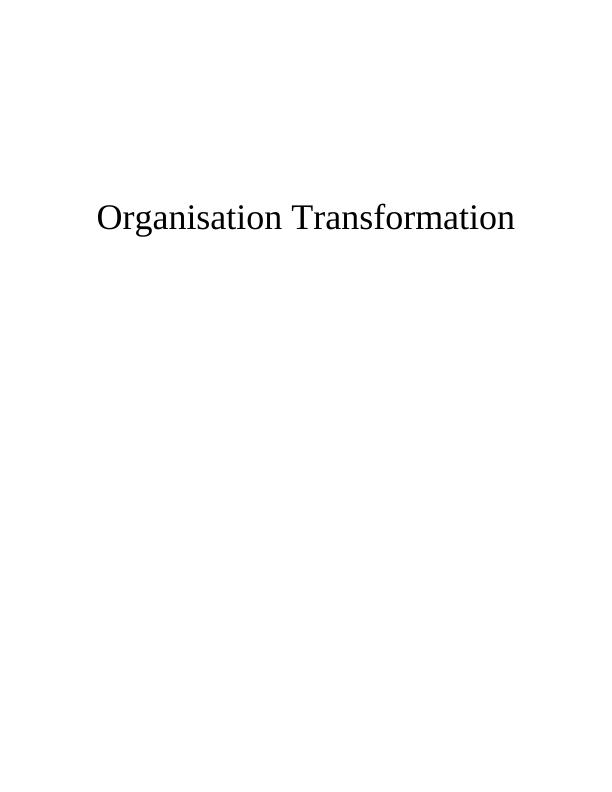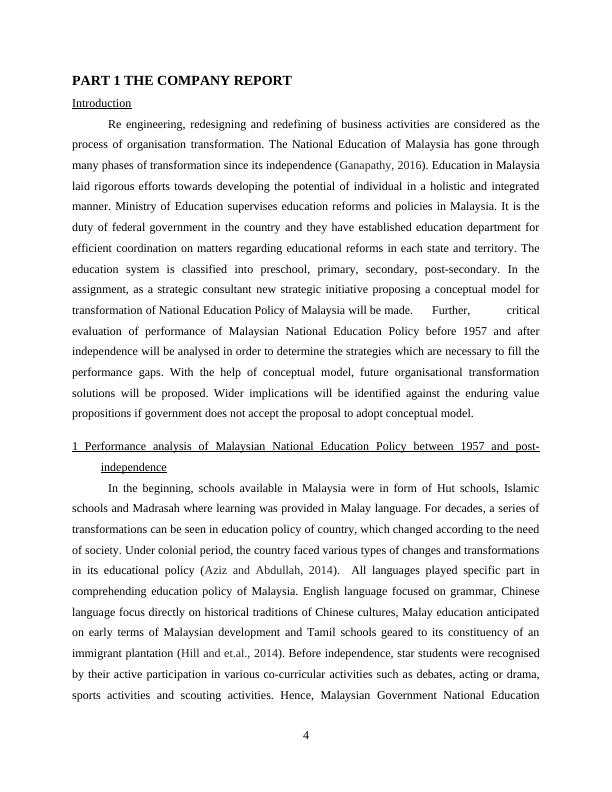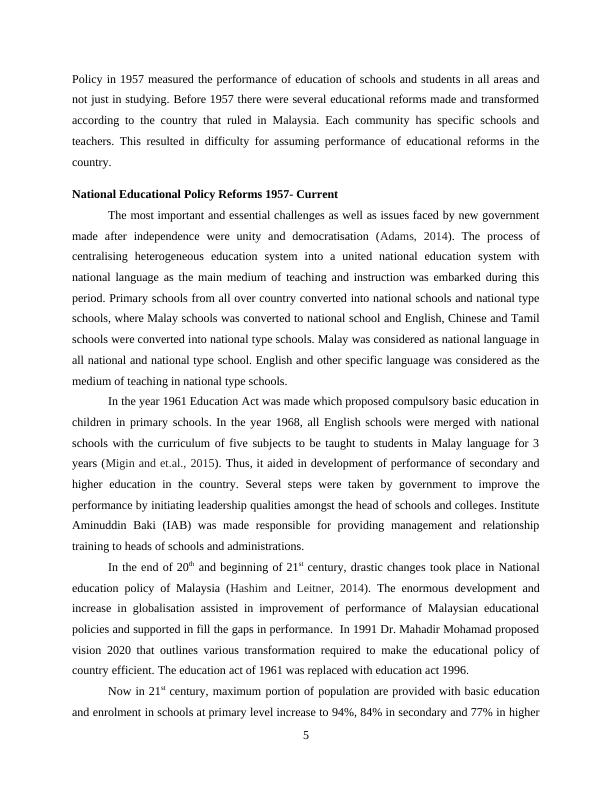Ask a question from expert
Organizational Transformation Strategies Report
29 Pages8607 Words110 Views
Added on 2020-07-22
Organizational Transformation Strategies Report
Added on 2020-07-22
BookmarkShareRelated Documents
Organisation Transformation

TABLE OF CONTENTSPART 1 THE COMPANY REPORT..............................................................................................1Introduction............................................................................................................................11 Performance analysis of Malaysian National Education Policy between 1957 and post-independence..........................................................................................................................12 Conceptual model to address performance shortfalls..........................................................83 Implication in the wider concept on non- acceptance of proposal. ..................................11Recommendations................................................................................................................13PART 2 EVIDENCE REVIEW.....................................................................................................151 Literature Review..............................................................................................................152 Outlining potential DBA research perspectives that could be adopted in the futuretransformation.......................................................................................................................18PART 3 REFLECTION FOR EMPLOYABILITY ENHANCEMENT.......................................20Critical thinking and core capabilities required to achieve the consultancy task.................20Evaluation of knowledge, skills and competencies..............................................................20Related leadership skills required for future personal development....................................21CONCLUSION..............................................................................................................................22REFERENCES..............................................................................................................................23

Index of TablesTable 1: Literacy Rate (above age 15)............................................................................................6Table 2: Type and Number of Schools with students in each school of Malaysia..........................6Table 3: Total number of schools in Malaysia.................................................................................7Table 4: Total Number of Schools in Malaysia...............................................................................7

PART 1 THE COMPANY REPORTIntroductionRe engineering, redesigning and redefining of business activities are considered as theprocess of organisation transformation. The National Education of Malaysia has gone throughmany phases of transformation since its independence (Ganapathy, 2016). Education in Malaysialaid rigorous efforts towards developing the potential of individual in a holistic and integratedmanner. Ministry of Education supervises education reforms and policies in Malaysia. It is theduty of federal government in the country and they have established education department forefficient coordination on matters regarding educational reforms in each state and territory. Theeducation system is classified into preschool, primary, secondary, post-secondary. In theassignment, as a strategic consultant new strategic initiative proposing a conceptual model fortransformation of National Education Policy of Malaysia will be made. Further, criticalevaluation of performance of Malaysian National Education Policy before 1957 and afterindependence will be analysed in order to determine the strategies which are necessary to fill theperformance gaps. With the help of conceptual model, future organisational transformationsolutions will be proposed. Wider implications will be identified against the enduring valuepropositions if government does not accept the proposal to adopt conceptual model.1 Performance analysis of Malaysian National Education Policy between 1957 and post-independenceIn the beginning, schools available in Malaysia were in form of Hut schools, Islamicschools and Madrasah where learning was provided in Malay language. For decades, a series oftransformations can be seen in education policy of country, which changed according to the needof society. Under colonial period, the country faced various types of changes and transformationsin its educational policy (Aziz and Abdullah, 2014). All languages played specific part incomprehending education policy of Malaysia. English language focused on grammar, Chineselanguage focus directly on historical traditions of Chinese cultures, Malay education anticipatedon early terms of Malaysian development and Tamil schools geared to its constituency of animmigrant plantation (Hill and et.al., 2014). Before independence, star students were recognisedby their active participation in various co-curricular activities such as debates, acting or drama,sports activities and scouting activities. Hence, Malaysian Government National Education4

Policy in 1957 measured the performance of education of schools and students in all areas andnot just in studying. Before 1957 there were several educational reforms made and transformedaccording to the country that ruled in Malaysia. Each community has specific schools andteachers. This resulted in difficulty for assuming performance of educational reforms in thecountry.National Educational Policy Reforms 1957- CurrentThe most important and essential challenges as well as issues faced by new governmentmade after independence were unity and democratisation (Adams, 2014). The process ofcentralising heterogeneous education system into a united national education system withnational language as the main medium of teaching and instruction was embarked during thisperiod. Primary schools from all over country converted into national schools and national typeschools, where Malay schools was converted to national school and English, Chinese and Tamilschools were converted into national type schools. Malay was considered as national language inall national and national type school. English and other specific language was considered as themedium of teaching in national type schools. In the year 1961 Education Act was made which proposed compulsory basic education inchildren in primary schools. In the year 1968, all English schools were merged with nationalschools with the curriculum of five subjects to be taught to students in Malay language for 3years (Migin and et.al., 2015). Thus, it aided in development of performance of secondary andhigher education in the country. Several steps were taken by government to improve theperformance by initiating leadership qualities amongst the head of schools and colleges. InstituteAminuddin Baki (IAB) was made responsible for providing management and relationshiptraining to heads of schools and administrations. In the end of 20th and beginning of 21st century, drastic changes took place in Nationaleducation policy of Malaysia (Hashim and Leitner, 2014). The enormous development andincrease in globalisation assisted in improvement of performance of Malaysian educationalpolicies and supported in fill the gaps in performance. In 1991 Dr. Mahadir Mohamad proposedvision 2020 that outlines various transformation required to make the educational policy ofcountry efficient. The education act of 1961 was replaced with education act 1996. Now in 21st century, maximum portion of population are provided with basic educationand enrolment in schools at primary level increase to 94%, 84% in secondary and 77% in higher5

education. It is because of the National Education Policy which enrich the vision of education asa means of holistic development of all people (Hamzah and et.al., 2014). There are variousperformance gaps that were identified during analysis of Malaysian education policy. Beforeindependence, students focus more on co-curricular activities whereas now students only focuson studying and avoiding participation in other activities. Thus, it results in declination ofperformance of students in other sectors. Another gap in performance of students was filled bythe Malaysian National Educational Policy by providing free and compulsory education for allchildren at primary level. According to results declared by Performance for InternationalStudents Assessment (PISA) in 2009, Malaysia ranks at 54 in comprehending, 57 inMathematics and 52 in Science thus, surpassing Indonesia and many countries in Asia. Thisstates that the performance of education increases tremendously and at rapid speed afterindependence of Malaysia (Goh and Wong, 2014).Comparison of Malaysian National Education Policy with Singapore Education PolicyAs per study conducted by Organisation for Economic Co-operation and Development(OECD), Out of 72 countries Singapore able to clinched the top spot whereas Malaysia's holdson 52nd position in terms of reading, maths and science. The education policies of Singapore are6Illustration 1: OECD Ranking for reading, math and science(Source: Ruxyn, 2016 )

End of preview
Want to access all the pages? Upload your documents or become a member.
Related Documents
Community Integration in Malaysian Societylg...
|15
|3711
|25
Education System Facing Disparity in Malaysialg...
|10
|2930
|56
Impact of Unemployment in Malaysia: Assignmentlg...
|14
|3410
|70
Assignment: Comparative and International Educationlg...
|20
|5116
|1
(Solved) Mind Mapping - Assignmentlg...
|9
|5972
|191